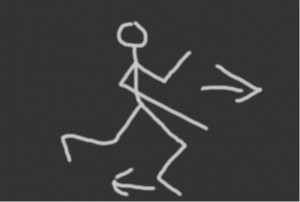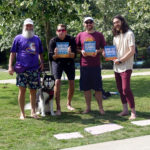Contents
I’ve heard that runners should never mess with technique, because it may hurt them?
Many of us have heard coaches and athletes bring out this old bone, which more accurately should be, “Don’t mess with successful technique.” But, most runners don’t know successful technique, and most people aren’t even runners, mostly because their running technique never was close to successful, in fact, quite often their technique was injurious, and at best, boring, un-stimulating, and painful.
The Old Days
When this rule came about, there were many factors at play. First of all, most coaches didn’t know how to teach successful running technique. Coaches were successful more for their skills in recruiting talented runners, than for their ability in improve running techniques of poor runners. And most people who were running, racing, and being coached were already successful. Coaches rarely worked with unsuccessful or “untalented” runners. And most runners who weren’t successful, didn’t continue running because running was more of an elite sport, with just a handful of competitors in most race events.
Now we see tens of thousands of runners (and walkers, crawlers, wheelchairs, etc.) in any big city marathon (and there’s more big city marathons than ever), even in some 5K races we’ll see just as many runners, or perhaps we should say, “participants” as many are walking, using wheelchairs, even crutches.
Coaches Teaching Technique
Today many people, regardless of talent, can find coaches willing to help them improve their running technique (or at least try to encourage them to run further and more often) for a price. Still, even for those who can afford private coaching, our most attentive teachers are the bare soles of our feet, which have long been ignored in the tenuous quest for improving running technique. Now, as we free our feet from imprisonment, we once again have these tools available to us, to help re-learn, or fine-tune our running technique.
What about messing with “successful” technique?
Tiger Woods, arguably one of the most successful golfers ever, is now on his third re-tooling of his swing technique. The first two times he re-tooled, he came out better than before. It may be too soon to tell if the third time will also be an improvement, but it really doesn’t matter, at least he’ll know, one way or the other, and if it doesn’t improve his game, he go back to one of the other techniques that were successful for him, or look at other ways to re-tool his technique.
Old pros, like Nicklous, Watson, and Palmer didn’t have coaches who taught or analyzed technique like we have today. This was true for running as well. Athletes might occasionally get a hint from a coach about fine-tuning, but mostly each athlete worked it out for themselves.
In high-jumping, when Dick Fosbury first used the Fosbury Flop, people thought it was ridiculous, that is until Fosbury won gold at the 1968 Summer Olympics… Of course, the Fosbury Flop would have been ridiculous in the old days, before thick landing cushions were used. Kind of like “jogging” (over-striding or heel-striking) would have been ridiculous (and still is) for barefoot runners and old-style racing flats. Jogging didn’t come to fashion until that sort of landing was made comfortable by modern over-cushioned running shoes. Of course, it isn’t a very successful way to run, that is not many races are won by people who hit the brakes with each and every step. Races are still mostly won by people in thin running shoes (or bare feet), whose technique contributes to forward motion (the heel-strike that occurs when we over-stride has a decelerating/braking effect on each step).
But, back to Tiger Woods, who is currently being criticized once again for messing with his unparalleled success by re-tooling his swing for the third time in his career. You’d think the critics would have learned by now, after all, the first two times he re-tooled his swing, he became a better golfer. I guess, like barefoot running, critics often fail to take into account feedback. Tiger Woods, in playing with his technique is going to be constantly paying attention to how it affects his game, and if some changes don’t have any indication of contributing to a better game, he’s going to be looking for other changes.
It’s much like evolution; it isn’t just a bunch of random mutations – it’s a bunch of random mutations tested over and over again by the environment in which they occur. Those changes that don’t work well, don’t continue for long.
Likewise with barefoot running, except the feedback is even more immediate; if it doesn’t feel good on the bare soles, then that is probably the best indication that a particular change in technique isn’t going to improve our running. Contrariwise, if it feels great on our bare soles, especially on various surfaces and terrains, then that is an excellent indication that we are becoming more efficient, graceful runners.
But, for those who are satisfied with the way things are, even if one is on top, well, you probably won’t stay on top for long. Fact is, one of the cornerstones of modern quality assurance is, not being satisfied with being “good enough”, but rather, continuous improvement. And no reason to wait to try to improve, just because you’re already faster than everyone else … whatever happened to “competing with oneself”? Doesn’t that apply to those in front, as well as those of us in the middle or back of the pack?
Even if we forget about those other fast runner behind us, who you can bet will be trying new ideas to increas their chances of catching you, if you aren’t willing to play with your technique, you’ll never know if you could be running better (or safer).
And, for most people, who are running badly enough to get injured frequently, there’s simply no good reason not try to improve your technique.
How to Play with Technique
First of all, try things that have worked for other successful runners. The basic techniques in “Barefoot Running Step by Step“, or the How page on this website, or from other “barefoot” coaches, are a good places to begin. These are just basics, starting points, which have been tested successfully by many other runners, particularly barefoot runners. And it is barefoot runners who require the best technique to avoid immediate pain in the bare soles as they interact with the running surface; it hurts to run badly barefoot, which is why we tend to learn to run better, sooner.
Advanced Barefoot Technique
I’ll be writing some articles about Advanced Barefoot Techniques soon
Posted in: technique

